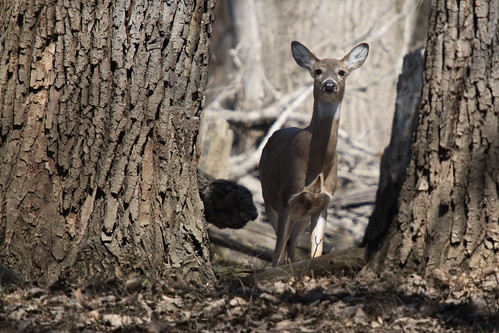When it arrived I wanted so much to put it to use, but with no foliage outside it was hard to find a subject. Pine trees, I was told, should appear white, but for whatever reason it just never seemed to work for me. I did get a couple test pics, however, of a houseplant under a halogen light -that seemed to work.
But now that it's April and we've finally got green grass (and buds on the trees), I went out on Wednesday to try to take some pictures. It was slightly overcast, near noon, and I used my sweater draped over the entire camera (and held loosely around the filter) to shield the entire thing from light.
One problem I knew would be a challenge is the fact that IR photography with a non-converted camera requires long exposures and it was windy out that day. I knew I'd get some blur due to the wind, but tried to take lots of pictures to increase my chances of a getting a good shot via luck. I figured even with the blur I should be able to see how well the filter works...
Well, the end results were unusable. Not only was there blur, there was also light leakage from somewhere because I got a reflection of the lens assembly that can be seen clear as day in every shot. The long exposures and the resulting need for a tripod and blur due to wind as well as the need to line up the shot, insert the filter, cover the camera to block light intrusion, etc all add up to a big pain in the you-know-what.
So, for the last couple days I've been looking into getting a second camera and having it converted to infrared. The cost varies greatly depending on how you want to buy:
- A USED, CONVERTED Canon Rebel XT sold on eBay today for $551.52
- A USED, UNCONVERTED Canon Rebel XT goes for about $350-$400
- A USED, UNCONVERTED Canon Rebel XTI or 20D goes for about $450-$500
- A NEW, UNCONVERTED Canon Rebel XTI goes for $509
- IR conversion service costs $400 for any Canon SLR
- A NEW, CONVERTED, NON-EBAY Canon Rebel XT costs $950
- A NEW, CONVERTED, NON-EBAY Canon Rebel XTI costs $1275 from www.maxmax.com !!!
In short, getting a new converted camera from maxmax.com seems to be a rip-off. Their conversions are $50 more than the more popular LifePixel as well. It's disappointing that no one else out there is offering already converted cameras at set prices. I missed that eBay auction today because I'm just no good at remembering when it ends and going through the trouble of bidding and all that is a pain (IMO). Ebay seems to be the cheapest option, but I've seen some cameras go for ridiculous amounts, so it's really all about waiting for luck to be in your favor.
I don't know if I'll be able to hold out for another auction. I'm going on a trip next month and I'd really like to have an IR body with me. I'll post more as I figure it out. I emailed maxmax.com about their pricing to see if they'll be coming down anytime soon. Probably not, but worth a try.
Oh, and to preemptively answer the question of "why not film" -it seems to be hard to find a place that'll process it. I'm also unsure about whether my film body has an IR filter like all digital SLR's do. I'm also quite dependent on having instant feedback and histograms. Some call it lazy, maybe it is, but I do whatever gets me the image I want the easiest, and that's digital. Even though it IS a money pit >:-P
In the meantime, I do plan to take a minute or two this weekend to re-try my IR filter. I may not be able to fix the long exposures, but there has to be a way to eliminate those reflections, then maybe I can just hope for a day or two without wind... :-\ Something's gotta give. I really want to jump on this new IR bandwagon. Some of the photos I've seen are amazing!
